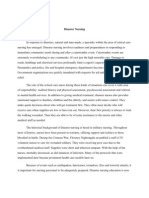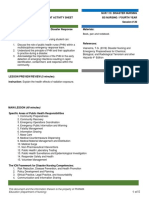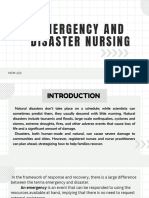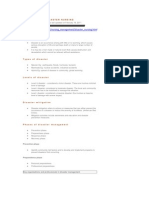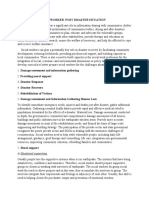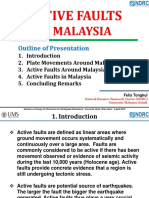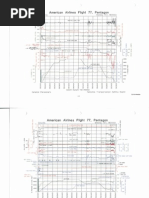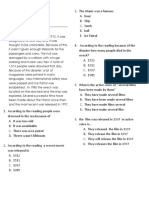0 ratings0% found this document useful (0 votes)
26 viewsGlobal Issue
Global Issue
Uploaded by
Ckaye GansubinNurses play a pivotal role in safeguarding public health during natural disasters and public health emergencies. However, nursing education, practice, research, and policy need fundamental reform to ensure nurses have the necessary knowledge, skills, and autonomy to protect at-risk populations and support the nursing workforce. Professional preparation of nurses to manage disasters is critical for effective rescue and response efforts. Nurses working in disaster settings must have clear leadership and policies to guide their response. While nurses are key to disaster response teams, many experience psychological distress due to lack of management, communication, and resources.
Copyright:
© All Rights Reserved
Available Formats
Download as DOCX, PDF, TXT or read online from Scribd
Global Issue
Global Issue
Uploaded by
Ckaye Gansubin0 ratings0% found this document useful (0 votes)
26 views2 pagesNurses play a pivotal role in safeguarding public health during natural disasters and public health emergencies. However, nursing education, practice, research, and policy need fundamental reform to ensure nurses have the necessary knowledge, skills, and autonomy to protect at-risk populations and support the nursing workforce. Professional preparation of nurses to manage disasters is critical for effective rescue and response efforts. Nurses working in disaster settings must have clear leadership and policies to guide their response. While nurses are key to disaster response teams, many experience psychological distress due to lack of management, communication, and resources.
Original Title
global-issue
Copyright
© © All Rights Reserved
Available Formats
DOCX, PDF, TXT or read online from Scribd
Share this document
Did you find this document useful?
Is this content inappropriate?
Nurses play a pivotal role in safeguarding public health during natural disasters and public health emergencies. However, nursing education, practice, research, and policy need fundamental reform to ensure nurses have the necessary knowledge, skills, and autonomy to protect at-risk populations and support the nursing workforce. Professional preparation of nurses to manage disasters is critical for effective rescue and response efforts. Nurses working in disaster settings must have clear leadership and policies to guide their response. While nurses are key to disaster response teams, many experience psychological distress due to lack of management, communication, and resources.
Copyright:
© All Rights Reserved
Available Formats
Download as DOCX, PDF, TXT or read online from Scribd
Download as docx, pdf, or txt
0 ratings0% found this document useful (0 votes)
26 views2 pagesGlobal Issue
Global Issue
Uploaded by
Ckaye GansubinNurses play a pivotal role in safeguarding public health during natural disasters and public health emergencies. However, nursing education, practice, research, and policy need fundamental reform to ensure nurses have the necessary knowledge, skills, and autonomy to protect at-risk populations and support the nursing workforce. Professional preparation of nurses to manage disasters is critical for effective rescue and response efforts. Nurses working in disaster settings must have clear leadership and policies to guide their response. While nurses are key to disaster response teams, many experience psychological distress due to lack of management, communication, and resources.
Copyright:
© All Rights Reserved
Available Formats
Download as DOCX, PDF, TXT or read online from Scribd
Download as docx, pdf, or txt
You are on page 1of 2
In the past decade, 2.
6 billion people around the world have been affected by
earthquakes, floods, hurricanes, and other natural disasters. Nurses have been
and continue to be pivotal in safeguarding the public during and after these
disasters, as well as public health emergencies—most recently, the COVID-19
pandemic. They educate and protect people, engage with and build trust with the
community, help people prepare and respond, and foster resilience to help
communities fully recover. But fundamental reform is needed in nursing education,
practice, research, and policy across both health care and public health settings to
ensure that all nurses—from front-line professionals to researchers—have the
baseline knowledge, skills, abilities, and autonomy they need to protect
populations at greatest risk and improve the readiness, safety, and support of the
nursing workforce.
A disaster relief nurse needs to be ready for it all. This type of nursing is collaborative
and physical. Many volunteers do additional tasks like distributing clothing, providing
emotional support, or sweeping floors. In disaster response, nurses aren’t afraid to get
dirty — literally.
Professional preparation of nurses to manage disasters is critical to safe and
effective rescue and response. Nurses working in disaster settings must have clear
leadership, and disaster rescue policies to ensure they can react to disaster
situations (Li et al., 2017). Many nurses who have reported being a part of disaster
response teams experience psychological distress—exacerbated by lack of effective
management, communication mechanisms and resources (Mao, Fung, Hu, &
Loke, 2018). In 2019, the International Nursing Council (ICN) and the World Health
Organization (WHO) jointly proposed a framework for disaster care offering
statements on diagnoses, outcomes and interventions appropriate to disaster
response (ICN, 2019). These capture the physiological, psychological social and
environmental needs of patients and their families. However, there is limited
information to evaluate how nurses cope with disasters. There are also calls for us
to look more closely at how nurse experiences can be used to inform training
strategies and curricula which may be specifically designed to prepare nurses to
work effectively in disaster settings.
Professional nursing skills in disaster response are critical. In a time of significant
global warming (Schenk, 2019), natural disasters are increasing and earthquakes,
tsunami, volcanic activity, floods and landslides more commonplace. In just one
decade (2007 to 2017), human deaths from natural disasters are estimated at
60,000. During the more recent coronavirus (COVID-19) outbreak, nurses have been
key to the disaster response teams, relying on their clinical skills and on heuristics
so that they could adequately manage complex clinical demands in highly complex
and volatile situations. All nurses have to be responsive and they must be able to
provide effective disaster relief (Alpert et al., 2018).
What Does a Disaster Relief Nurse Do?
A disaster relief nurse provides the necessary care and treatment during an emergency, such as a
natural disaster, terrorist attack, or other crises that require an immediate medical response for
the community. In this position, you typically work with a relief group and travel to locations in
need of your services. Your primary responsibilities are to assist first responders and other health
care providers with treating injuries and illnesses. Your duties may also include helping to
stabilize an area and create a safe environment so you can provide medical care to patients. This
job requires excellent interpersonal, communication, and critical thinking skills, as well as the
ability to act quickly and remain calm in high-stress situations.
Roles and Responsibilities of Disaster Relief Nurses
A nurse’s role in emergency situations is primarily to provide care and treatment to
victims of natural disasters, such as floods, hurricanes, and earthquakes. Emergency
nursing duties include:
Examining patients
Caring for injuries
Stabilizing critical patients
Providing first aid and CPR
Giving IV fluids
Administering medications
Depending on the situation, you might end up treating patients in a healthcare facility or
in the field. Volunteers should prepare for the possibility of working in primitive
conditions. This may include having insufficient food, shelter, running water, supplies, or
other essentials.
You might also like
- Barangay Disaster Risk Reduction and Management Plan: Years CoveredDocument53 pagesBarangay Disaster Risk Reduction and Management Plan: Years CoveredAdin Alden92% (53)
- GROUP 6 Personal Roles and Functions For Disaster Preparedness and Responses PlansDocument4 pagesGROUP 6 Personal Roles and Functions For Disaster Preparedness and Responses PlansMary Ruth Cruz67% (3)
- Harvard Design Magazine - Shifting Landscapes In-Between TimesDocument10 pagesHarvard Design Magazine - Shifting Landscapes In-Between TimesSandra FremNo ratings yet
- Contingency PlanDocument26 pagesContingency PlanSaligan Dolf100% (2)
- I D D N: Ntroduction To Isasters AND Isaster UrsingDocument11 pagesI D D N: Ntroduction To Isasters AND Isaster UrsingJenny Pearl InfanteNo ratings yet
- Disaster PrepardnessDocument11 pagesDisaster Prepardnesssamantha harrynananNo ratings yet
- The Role, Preparedness and Management of Nurses During Disasters 1325648617Document26 pagesThe Role, Preparedness and Management of Nurses During Disasters 1325648617Pepper Mint0% (1)
- OPD ReadingsDocument7 pagesOPD ReadingsEm ArellanoNo ratings yet
- Introduction Disaster NursingDocument11 pagesIntroduction Disaster NursingydtrgnNo ratings yet
- Nursing DisasterDocument10 pagesNursing DisasterReymon Jan RodadoNo ratings yet
- Disaster Nursing - Icn Position and Recommendation - Rotone, Lycah v. - BSN 4yb-4Document3 pagesDisaster Nursing - Icn Position and Recommendation - Rotone, Lycah v. - BSN 4yb-4Lycah RotoneNo ratings yet
- Disaster NursingDocument4 pagesDisaster NursingIrfan FauziNo ratings yet
- Disaster Response Report FinalDocument5 pagesDisaster Response Report FinalrutthhwkNo ratings yet
- Module 2 DNDocument2 pagesModule 2 DNDYNA GISELLE ROMERONo ratings yet
- The Goal of Disaster NursingDocument13 pagesThe Goal of Disaster NursingPrince Mark BadilloNo ratings yet
- Earthquake Template 16x9Document24 pagesEarthquake Template 16x9Jason Lee YapNo ratings yet
- APEDNN Curricular Framework in Emergency and Disaster Nursing - Sept2009Document35 pagesAPEDNN Curricular Framework in Emergency and Disaster Nursing - Sept2009janus5zu5iga5de5leonNo ratings yet
- 2015 Conference 10Document11 pages2015 Conference 10fiora.ladesvitaNo ratings yet
- ICN Framework of Disaster Nursing CompetenciesDocument27 pagesICN Framework of Disaster Nursing CompetenciesChannelG100% (1)
- Disaster Nursing SAS Session 20Document5 pagesDisaster Nursing SAS Session 20Niceniadas CaraballeNo ratings yet
- Nurses and Disaster Risk Reduction, Response and RecoveryDocument6 pagesNurses and Disaster Risk Reduction, Response and RecoveryCkaye GansubinNo ratings yet
- Nurses Role During A DisasterDocument4 pagesNurses Role During A DisasterNaomi RebongNo ratings yet
- We Are Intechopen, The World'S Leading Publisher of Open Access Books Built by Scientists, For ScientistsDocument15 pagesWe Are Intechopen, The World'S Leading Publisher of Open Access Books Built by Scientists, For ScientistsDamin FyeNo ratings yet
- Lozano Disaster Nursing PDFDocument21 pagesLozano Disaster Nursing PDFDeva Hiyas100% (1)
- Documentation of Disaster ManagementDocument5 pagesDocumentation of Disaster Managementjannasharielawan9No ratings yet
- Cu 4 Nurses Role in Disaster Nursing 2Document11 pagesCu 4 Nurses Role in Disaster Nursing 2Kathleen Dela CruzNo ratings yet
- Disaster Preparedness in Philippine Nurses: World HealthDocument9 pagesDisaster Preparedness in Philippine Nurses: World HealthTiwi Dewi WulanNo ratings yet
- Running Head: Catastrophic Earthquake in Haiti 1Document4 pagesRunning Head: Catastrophic Earthquake in Haiti 1Rock KephaNo ratings yet
- Roles of Health Care Providers in Sto. Niño Health Center: Fire Disaster PreparednessDocument24 pagesRoles of Health Care Providers in Sto. Niño Health Center: Fire Disaster PreparednessOoLvs XibNo ratings yet
- Gray White Simple Modern Thesis Defense PresentationDocument23 pagesGray White Simple Modern Thesis Defense PresentationALFEREZ JAMES MATTHEW S.No ratings yet
- Educating Nursing Students On Emergency Preparedness - A Pilot ProDocument57 pagesEducating Nursing Students On Emergency Preparedness - A Pilot ProTiwi Dewi Wulan100% (1)
- Trauma PresentationDocument41 pagesTrauma Presentationceo.kristopherNo ratings yet
- Disaster Risk Management and MitigationDocument5 pagesDisaster Risk Management and MitigationMarivic DianoNo ratings yet
- Comprehensive Care Plan For Uncontrolled Chronic Diseases and Local Disaster ResilienceDocument6 pagesComprehensive Care Plan For Uncontrolled Chronic Diseases and Local Disaster ResilienceandriikobernykNo ratings yet
- Disaster NursingDocument7 pagesDisaster NursingAmal B Chandran100% (1)
- NCM 121 LP 2 ContentDocument13 pagesNCM 121 LP 2 ContentKycilene Palma100% (1)
- LPN RoleDocument3 pagesLPN RolealymarinebiologistNo ratings yet
- DRMPDocument14 pagesDRMPJomyNo ratings yet
- Critiquing An Evideced Based JournalDocument8 pagesCritiquing An Evideced Based JournalnycaNo ratings yet
- The Perception of Disaster Preparedness Among Filipino Nursing StudentsDocument135 pagesThe Perception of Disaster Preparedness Among Filipino Nursing StudentsReginald Don Destura100% (3)
- Population - Term Used To Describe The Recipients of The Health Motion and Disease and DisabilityDocument4 pagesPopulation - Term Used To Describe The Recipients of The Health Motion and Disease and DisabilityJohn FredNo ratings yet
- HIJNRP_Volume 3_Issue 5_Pages 16-32Document17 pagesHIJNRP_Volume 3_Issue 5_Pages 16-32Adam Mahad SaladNo ratings yet
- Disaster Nursing SAS Session 14Document6 pagesDisaster Nursing SAS Session 14Niceniadas CaraballeNo ratings yet
- The Philippine Disaster and Risk ProfileDocument10 pagesThe Philippine Disaster and Risk ProfileMedardo AbenisNo ratings yet
- The Lived Experience of Filipino Nurses' Work in COVID-19 Quarantine Facilities: A Descriptive Phenomenological StudyDocument11 pagesThe Lived Experience of Filipino Nurses' Work in COVID-19 Quarantine Facilities: A Descriptive Phenomenological StudyAldrin Zolina100% (1)
- Research Chapter 1Document20 pagesResearch Chapter 1MidaRadamNo ratings yet
- C Millet Post Ver 073113Document37 pagesC Millet Post Ver 073113Ferry Nirwana Ade SaputraNo ratings yet
- Nurses RoleDocument14 pagesNurses RolesweetpeaNo ratings yet
- Preparation of Nurses To Disaster ManagementDocument10 pagesPreparation of Nurses To Disaster Managementai nisa hasnasariNo ratings yet
- Justification of The StudyDocument2 pagesJustification of The StudyAxiel Jay DanipogNo ratings yet
- Presented By: Jyoti 1 MSC (N)Document27 pagesPresented By: Jyoti 1 MSC (N)Jýóťî ĎhóñìNo ratings yet
- Social Work in The Midst of PandemicDocument3 pagesSocial Work in The Midst of Pandemicwilliam bill doriaNo ratings yet
- The Role of Public Health in Disaster Preparedness and Response (WWW - Kiu.ac - Ug)Document4 pagesThe Role of Public Health in Disaster Preparedness and Response (WWW - Kiu.ac - Ug)publication1No ratings yet
- Teaching Disaster Nursing by Utilizing The Jennings Disaster Nursing Management ModelDocument9 pagesTeaching Disaster Nursing by Utilizing The Jennings Disaster Nursing Management Modelyuihan oshiNo ratings yet
- Attitude ScaleDocument15 pagesAttitude ScaleJones PhoneNo ratings yet
- Figure 1. Disaster Management Continuum: Prevention/MitigationDocument4 pagesFigure 1. Disaster Management Continuum: Prevention/MitigationSovia fitriaNo ratings yet
- Disaster NursingDocument5 pagesDisaster NursingjebashanthiniNo ratings yet
- Disaster NRSNG 1Document19 pagesDisaster NRSNG 1Khatlene Joy RaymundoNo ratings yet
- FAEN Module Hand OutsDocument96 pagesFAEN Module Hand OutsZarlou OtamiasNo ratings yet
- Community Emergency Management, Disaster Recovery and ResilienceFrom EverandCommunity Emergency Management, Disaster Recovery and ResilienceNo ratings yet
- Animal Management in Disasters, Volume 1, Animals and PeopleFrom EverandAnimal Management in Disasters, Volume 1, Animals and PeopleNo ratings yet
- Beyond COVID-19: Psychological Resilience in Health WorkersFrom EverandBeyond COVID-19: Psychological Resilience in Health WorkersNo ratings yet
- Blancia College Foundation Inc - 1Document2 pagesBlancia College Foundation Inc - 1Ckaye GansubinNo ratings yet
- Personal VitaeDocument3 pagesPersonal VitaeCkaye GansubinNo ratings yet
- Surgical Delivery SlipDocument5 pagesSurgical Delivery SlipCkaye GansubinNo ratings yet
- Surgical Delivery SlipDocument6 pagesSurgical Delivery SlipCkaye GansubinNo ratings yet
- Nurses and Disaster Risk Reduction, Response and RecoveryDocument6 pagesNurses and Disaster Risk Reduction, Response and RecoveryCkaye GansubinNo ratings yet
- MyocarditisDocument11 pagesMyocarditisCkaye GansubinNo ratings yet
- Module 2 Pop 1Document13 pagesModule 2 Pop 1Ckaye GansubinNo ratings yet
- Disaster. BSN Iv3Document63 pagesDisaster. BSN Iv3Ckaye GansubinNo ratings yet
- Group6 Pregnant and CultureDocument3 pagesGroup6 Pregnant and CultureCkaye GansubinNo ratings yet
- NURSING LEADERSHIP AND MANAGEMENT MidDocument4 pagesNURSING LEADERSHIP AND MANAGEMENT MidCkaye GansubinNo ratings yet
- Flood: Galață Larisa Petre Ștefan Aldea Dragoș Bodea VictorDocument7 pagesFlood: Galață Larisa Petre Ștefan Aldea Dragoș Bodea Victorlarisa galațăNo ratings yet
- The Role of Social Worker-Post Disaster SituationDocument4 pagesThe Role of Social Worker-Post Disaster SituationDenver John Tacderas SolivenNo ratings yet
- Disaster ClassificationDocument8 pagesDisaster Classificationaggrey noahNo ratings yet
- Unit 1 Nature of DisastersDocument30 pagesUnit 1 Nature of DisastersacornaNo ratings yet
- Disaster Management and Mitigation For Earthquakes: Are We Ready?Document12 pagesDisaster Management and Mitigation For Earthquakes: Are We Ready?Adarsh Editing ytNo ratings yet
- Louis Cryer Was 18 and in Sri Lanka With His MotheDocument3 pagesLouis Cryer Was 18 and in Sri Lanka With His MotheWendy Yeong0% (1)
- Active Faults in MalaysiaDocument52 pagesActive Faults in MalaysiaHazim HaNo ratings yet
- Case Study-Housing - Group 1Document10 pagesCase Study-Housing - Group 1jantraquenaNo ratings yet
- Earthquake LoadsDocument32 pagesEarthquake LoadsJervic Souichiro ChavezNo ratings yet
- Kumbh Mela Case Study FullDocument58 pagesKumbh Mela Case Study Fullhsvm1989No ratings yet
- Donald B Burness Pieter Bruegel Painters For PoetsDocument7 pagesDonald B Burness Pieter Bruegel Painters For PoetskbantleonNo ratings yet
- t7 b3 CVR Notes - NTSB FDR - Aa 77 NTSB FDR Analysis 316Document17 pagest7 b3 CVR Notes - NTSB FDR - Aa 77 NTSB FDR Analysis 3169/11 Document ArchiveNo ratings yet
- People vs. ArpaDocument1 pagePeople vs. ArpaEthan KurbyNo ratings yet
- Great Molasses Flood: Jump To Navigation Jump To SearchDocument5 pagesGreat Molasses Flood: Jump To Navigation Jump To SearchBogdanelNo ratings yet
- Disaster Risk Reduction - Good Practices and Lessons LearnedDocument108 pagesDisaster Risk Reduction - Good Practices and Lessons LearnedFrances Gallano Guzman AplanNo ratings yet
- Margie IpcrDocument2 pagesMargie IpcrMargie ArlanticoNo ratings yet
- Evaluation of English Passive VoiceDocument2 pagesEvaluation of English Passive VoiceWilmer David RoaNo ratings yet
- 01 Handout 3rDocument4 pages01 Handout 3rKlent Joseph N. RojoNo ratings yet
- Using Textual EvidenceDocument5 pagesUsing Textual Evidenceluciamagali.cosNo ratings yet
- CE-700 Working Group Initial Cessna 310 May 28, 2018Document5 pagesCE-700 Working Group Initial Cessna 310 May 28, 2018Elmer VillegasNo ratings yet
- GP ExcellenceDocument25 pagesGP ExcellenceVarshLokNo ratings yet
- Speaking Test Questions Right On 8Document5 pagesSpeaking Test Questions Right On 8Lê Thị Ngọc ÁnhNo ratings yet
- Department of Social Welfare and Development (DSWD) (Philippines)Document5 pagesDepartment of Social Welfare and Development (DSWD) (Philippines)Camille T. Sanchez100% (1)
- Midterm Exam DRRR Sy 2018 2019Document6 pagesMidterm Exam DRRR Sy 2018 2019carl manaayNo ratings yet
- Conversation Questions RescueDocument5 pagesConversation Questions Rescueannpalomo622No ratings yet
- Turning The Humanitarian System On Its Head: Saving Lives and Livelihoods by Strengthening Local Capacity and Shifting Leadership To Local ActorsDocument56 pagesTurning The Humanitarian System On Its Head: Saving Lives and Livelihoods by Strengthening Local Capacity and Shifting Leadership To Local ActorsOxfamNo ratings yet
- Natural Disasters Pre Exam 2nd Grade PDFDocument2 pagesNatural Disasters Pre Exam 2nd Grade PDFAlison CasaNo ratings yet









